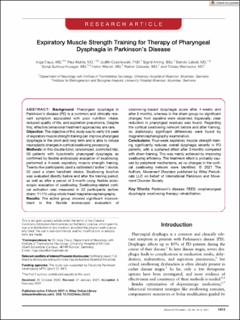| dc.contributor.author | Claus, I. | |
| dc.contributor.author | Muhle, P. | |
| dc.contributor.author | Czechowski, J. | |
| dc.contributor.author | Ahring, S. | |
| dc.contributor.author | Labeit, B. | |
| dc.contributor.author | Suntrup‐Krueger, S. | |
| dc.contributor.author | Wiendl, H. | |
| dc.contributor.author | Dziewas, R. | |
| dc.contributor.author | Warnecke, T. | |
| dc.date.accessioned | 2021-10-05T11:24:39Z | |
| dc.date.available | 2021-10-05T11:24:39Z | |
| dc.date.issued | 2021 | |
| dc.identifier.citation | Claus, I., Muhle, P., Czechowski, J., Ahring, S., Labeit, B., Suntrup‐Krueger, S., Wiendl, H., Dziewas, R. and Warnecke, T. (2021), Expiratory Muscle Strength Training for Therapy of Pharyngeal Dysphagia in Parkinson's Disease. Mov Disord. | en_US |
| dc.identifier.uri | https://hdl.handle.net/11250/2787695 | |
| dc.description.abstract | Background
Pharyngeal dysphagia in Parkinson's disease (PD) is a common and clinically relevant symptom associated with poor nutrition intake, reduced quality of life, and aspiration pneumonia. Despite this, effective behavioral treatment approaches are rare.
Objective
The objective of this study was to verify if 4 week of expiratory muscle strength training can improve pharyngeal dysphagia in the short and long term and is able to induce neuroplastic changes in cortical swallowing processing.
Methods
In this double-blind, randomized, controlled trial, 50 patients with hypokinetic pharyngeal dysphagia, as confirmed by flexible endoscopic evaluation of swallowing, performed a 4-week expiratory muscle strength training. Twenty-five participants used a calibrated (“active”) device, 25 used a sham handheld device. Swallowing function was evaluated directly before and after the training period, as well as after a period of 3 month using flexible endoscopic evaluation of swallowing. Swallowing-related cortical activation was measured in 22 participants (active:sham; 11:11) using whole-head magnetencephalography.
Results
The active group showed significant improvement in the flexible endoscopic evaluation of swallowing–based dysphagia score after 4 weeks and after 3 months, whereas in the sham group no significant changes from baseline were observed. Especially, clear reduction in pharyngeal residues was found. Regarding the cortical swallowing network before and after training, no statistically significant differences were found by magnetencephalography examination.
Conclusions
Four-week expiratory muscle strength training significantly reduces overall dysphagia severity in PD patients, with a sustained effect after 3 months compared with sham training. This was mainly achieved by improving swallowing efficiency. The treatment effect is probably caused by peripheral mechanisms, as no changes in the cortical swallowing network were identified. © 2021 The Authors. Movement Disorders published by Wiley Periodicals LLC on behalf of International Parkinson and Movement Disorder Society | en_US |
| dc.publisher | Movement Disorders | en_US |
| dc.rights | Attribution-NonCommercial-NoDerivatives 4.0 Internasjonal | * |
| dc.rights.uri | http://creativecommons.org/licenses/by-nc-nd/4.0/deed.no | * |
| dc.subject | Parkinson's disease | en_US |
| dc.subject | FEES | en_US |
| dc.subject | oropharyngeal dysphagia | en_US |
| dc.subject | swallowing therapy | en_US |
| dc.subject | rehabilitation | en_US |
| dc.subject | nevrologiske lidelser | en_US |
| dc.title | Expiratory Muscle Strength Training for Therapy of Pharyngeal Dysphagia in Parkinson's Disease | en_US |
| dc.type | Journal article | en_US |
| dc.source.pagenumber | 1815-1824 | en_US |
| dc.source.volume | 36 | en_US |
| dc.source.journal | Movement Disorders | en_US |
| dc.source.issue | 8 | en_US |
| dc.identifier.doi | https://doi.org/10.1002/mds.28552 | |

